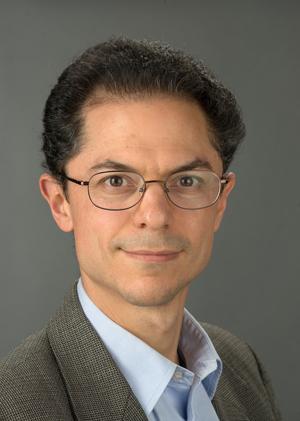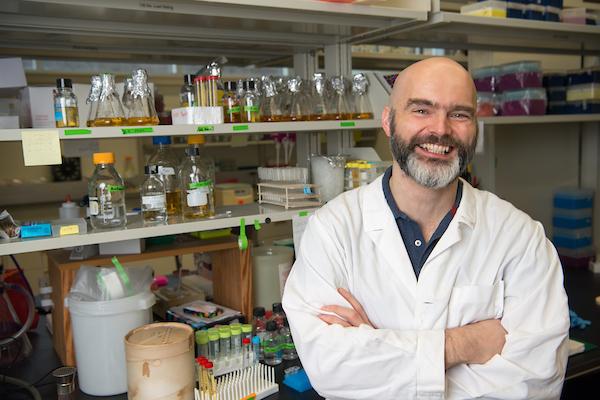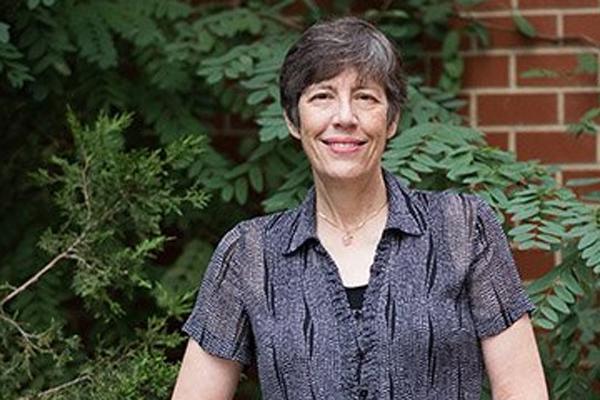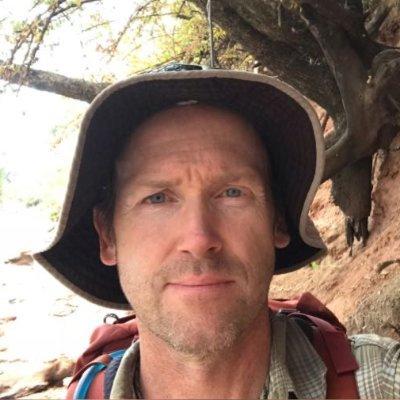
2022-23 Presidential Research Scholars are explorers of human history and scientific discovery

Ohio University has named four professors from arts and humanities and life and biomedical sciences as its 2022-23 Presidential Research Scholars: Neil Bernstein, Ronan Carroll, Katherine Jellison, and Patrick O’Connor.
"This year's scholars demonstrate the depth and breadth of our faculty member’s expertise, from historical studies — of Roman emperors and women post the Great Depression — to scientific discoveries — as large as a dinosaur and as small as a strand of RNA,” said David Koonce, interim vice president for research and creative activity.
The Presidential Research Scholars awards program is targeted to faculty members who have garnered national and international prominence in research, scholarship and creative activity and who demonstrate clear promise for continued, significant productivity in their research or creative activity.
Each award recipient receives $3,000 to be used at the scholar’s discretion as an honorarium or to support research or creative works.
This year, applications were sought for Life and Biomedical Sciences and Arts and Humanities. Next year, applications will be solicited in the categories of Social and Behavioral Sciences and Physical Sciences and Engineering.

Neil W. Bernstein: Bringing Roman literature and epic Latin poetry to a modern audience
At a university that's a little more than 200 years old, Neil W. Bernstein studies life and literature that's more than 2,000 years old. Spoiler alert: stories of love, war and politics abound, and the plotlines of ancient Rome still run through today's Hollywood blockbusters.
Bernstein's research focuses on Latin literature from the Roman imperial period — 27 BCE to 476 CE — a period of epic storytelling, narrative poetry, declarative speeches, and a lot of wars and social and political upheaval. Bernstein's translations and analyses help bring this era to life for modern students and scholars.
His first two books — "In the Image of the Ancestors: Narratives of Kinship in Flavian Epic" and "Ethics, Identity, and Community in Later Roman Declamation" — examine issues of family and community and ethical and social conflict in the early Roman imperial period. He's also written a book about the tragedy of Hercules, as told by playwright Seneca, as well as a textbook helping Latin students read the play.
More recently, Bernstein has translated and analyzed the writings of first-century poet and statesman Silius Italicus, particularly Punica, his 12,000-line epic poem on Rome's war with Carthage. His recent book, "Silius Italicus: Punica, Book 9," is the first full-scale commentary in English devoted to Punica 9, which begins the narrative of the Battle of Cannae in August 216 BC. His commentary in the book examines the disastrous Roman defeat at Cannae, the largest battle of the ancient Greco-Roman world.
Due out in January, Bernstein's latest book, "The Complete Works of Claudian," offers a modern and accessible translation of the poet Claudian’s work, published in English for the first time since 1922. Claudian (active 395-404 AD) was the last great classical Latin poet, and his poems were major influences on European art and literature.
Bernstein is a professor of classics and religious studies in the College of Arts and Sciences.

Ronan Carroll: Taking the fight against a dangerous microbe to its RNA
Ronan Carroll's team is looking for ways to stop a potent killer, one that is getting adept at resisting antibiotics.
Research in his lab involves a team of postdocs, graduate and undergraduate students with multiple projects, all focused on the bacteria Staphylococcus aureus, one of the leading causes of infection and death by a microbe in the United States with reports that it could account for between 10,000 and 15,000 deaths annually.
Treatment of Staphylococcus aureus infection is challenging as the bacteria has acquired resistance to a large number of commonly-used antibiotics. That's why Carroll's lab is exploring how the microbe causes disease so that they can discover new ways to fight it. One aspect of their research is the hundreds of regulatory and small RNAs (sRNAs) that are potential targets for antimicrobial therapy.
Carroll has already mapped the location of all known sRNAs on the Staphylococcus aureus genome, thus revolutionizing sRNA studies of the microbe. His work, funded by the National Institutes of Health and NASA, has led to may important discoveries, including a key one in his lab. Carroll has identified an sRNA called Teg41 that plays a crucial role in how Staphylococcus aureus produces toxins and how effectively these toxins attack a host cell.
Nearly a third of the human population already has Staphylococcus aureus living in their nose, an environment which runs about three degrees cooler than a person's core temperature. Carroll is working with Erin Murphy in the Heritage College of Osteopathic Medicine to study how the shift in temperature from the nose to the bloodstream could affect how RNA-based regulation and protein production might make the microbe more virulent.
Carroll is associate professor of biological sciences in the College of Arts and Sciences and associate director of the Infectious and Tropical Diseases Institute (ITDI).

Katherine Jellison: Looking back at women's role in consumer culture, rural history
In the media, Katherine Jellison is one of the most-quoted historians when it comes to women in the White House. But her research interests lie far afield from the nation's seat of power.
A scholar of U.S. women’s history, Jellison has a research portfolio developed around rural residents, particularly women, who helped build the U.S. consumer culture during the 20th century. Her first book, "Entitled to Power: Farm Women and Technology, 1913-1963," focuses on farm-based consumers. She has published numerous journal articles and book chapters on rural consumers of farm equipment, household appliances, commercialized entertainment and recreation, wartime propaganda, mass-produced clothing, and products and services of medical practitioners.
In her second book, "It's Our Day: America's Love Affair with the White Wedding, 1945-2005," Jellison shifts to a largely urban perspective to examine the nation's transition from home-based to big-business weddings.
Her latest book manuscript, "Amish Women and the Great Depression," goes back to Jellison's rural roots. She collaborates with co-author Steven Reschly of Truman State University to examine how Depression-era Amish women struck a balance between production and consumption to retain their family farms despite the economic crisis. The quantitative framework for their book involves a massive New Deal consumer study and interviews with 300,000 wives and mothers conducted by Works Progress Administration employees in 1935-36. Among the women participating in the study were members of the nation's oldest and best-known Amish community — the Old Order Amish of Lancaster County, Pennsylvania. Johns Hopkins University Press will publish the book in fall 2023.
Jellison is a professor of history in the College of Arts and Sciences and director of the Central Region Humanities Center. Jellison helped found the Rural Women's Studies Association and was recently named a fellow of the Agricultural History Society.

Patrick O’Connor: Exploring life on Earth before the mass extinction
Patrick O’Connor walks where dinosaurs once roamed and puts together the pieces of their environment left behind some 75-66 million years ago.
His research spans from animals alive today to those that existed long ago during the Late Cretaceous Period in Madagascar, eastern and northern Africa, and Antarctica. His work includes not only describing species new to science but also rigorously interpreting the ecosystems in which they lived.
Combining expeditionary fieldwork with laboratory- and museum-based comparative biology, O’Connor’s research utilizes multiple approaches to address hypotheses related to the evolution of organisms, ecosystems, and the Earth in a deep-time context. With continuous funding from the National Science Foundation and the National Geographic Society, he has discovered and named several new dinosaurs, crocodiles, and mammals while revealing novel insights about the changing face of the planet over the past 70 million years.
O'Connor's passion for his research is fueled by its multi-disciplinary nature. He works with diverse teams of biologists and geologists, along with artists and science communicators, to contextualize the recovered fossils and characterize past biotas and ecosystems from some of the most remote places on the planet. Together, they paint new pictures of life on Earth on southern hemisphere landmasses immediately preceding the planet's last mass extinction event at the end of the Mesozoic Era.
His work exploring ecosystem dynamics, animal extinction, and biotic recovery following mass extinctions is critical for understanding of how organisms fit within their ecosystems and how ecosystems respond to large-scale environmental change on the planet.
O'Connor is professor of neuroscience and anatomy in biomedical sciences in the Heritage College of Osteopathic Medicine, director of educational programs in the Heritage College Office of Research and Grants, and a member of the Ohio Center for Ecological and Evolutionary Studies.
